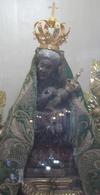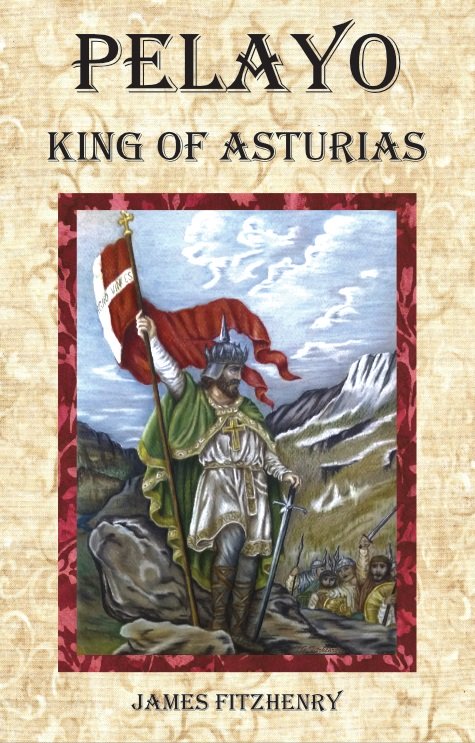Our Lady of Nazareth
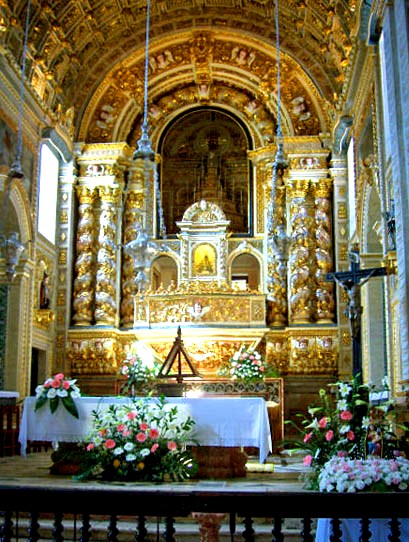
March 6: Our Lady of Nazareth, Pierre Noire, Portugal (1150)
The Abbot Orsini wrote: “This image was honored at Nazareth in the time of the apostles, if we may believe a writing which was found, by a hunter, attached to this image, in the year 1150.”
The Shrine of Our Lady of Nazareth, known in Portugal as Nossa Senhora da Nazare, is found in the village of Nazare on the Atlantic coast in Portugal. Indeed, the village is named after this miraculous statue of the Blessed Mother and the Christ Child that was brought to the area many centuries ago. According to tradition, this miraculous image was carved by the hands of Saint Joseph, the foster-father of Christ, while in the very presence of the Infant Jesus and the Mother of God. Later, the faces and hands of the images were painted by Saint Luke the Evangelist. This remarkable image is still preserved in a church where it can be viewed by anyone, and the story surrounding it is a fascinating one.
It is known that the statue of Our Lady of Nazareth came from the Holy Land where it was one of the oldest images ever venerated by Christians. It was saved from destruction at the hands of the iconoclasts sometime early in the 5th century by a monk named Ciriaco, who gave the statue to Saint Jerome. Saint Jerome later gave it to Saint Augustine in Africa, to protect the statue by removing it from the Holy Land. Saint Augustine then gave it into the safekeeping of the monastery of Cauliniana, near Merida, a monastery on the Iberian Peninsula.
Our Lady of Nazareth
When the Arabs invaded the Iberian Peninsula in the year 711, King Roderic met them with his Visigothic army at the battle of Guadalete, where he was soundly defeated.
It is a fact of history that the body of Roderic was never found upon the field of battle, although his horse was found, and it is often assumed by historians that Roderic died that day when he lost his kingdom. According to this legend, however, Roderic was not killed, but survived the battle and disguised himself as a beggar as he travelled north. Alone and unknown, he made his way to the monastery of Cauliniana where he sought shelter for the night. Going to confession, he of necessity revealed his true identity to the friar, Frei Romano. As it turned out, the monks were preparing to leave the monastery in advance of the Arabs, and so Frei Romano asked the king if he could accompany him in his travels. Roderic agreed, and the friar took with him the statue of Our Lady of Nazareth and the relics of Saint Bras and Saint Bartholomew.
They traveled together until they arrived at a place later named Monte de Saint Bartolomeu in November of the year 714. They made for themselves a hermitage with the friar living in a small cave at the edge of a cliff that overlooked the sea. He placed the image in a niche among the stones upon a pedestal of simple rocks. Roderic went a little ways off by himself to a hill where he also began to live the life of a hermit. After a year, though, King Roderic left the hermitage, and nothing else is said of him in this legend. One wonders if he ever learned of his kinsman Pelayo, who had retreated into the mountains and continued to heroically defy the invaders.
Before his death, Frei Romano hid the image in his small cave, where it remained undisturbed for some centuries until it was discovered by shepherds, who came there to venerate the statue. Inside that little, ancient sanctuary they had found the renowned and sacred image of Our Lady of Nazareth. Carved of wood, it was unlike any other statue of the Madonna they had ever seen, for it depicts the Blessed Virgin breastfeeding her Divine Child while seated upon a simple bench. When miracles began to frequently occur, it became a major pilgrimage center.
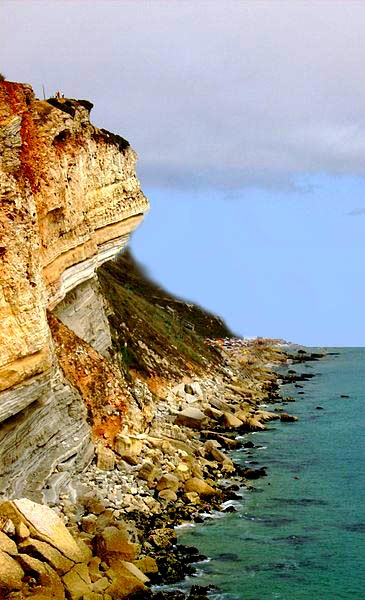
Then, in the early morning of September 14th in the year 1182, the mayor of Porto de Mos, Dom Fuas Roupinho, was hunting on his land when he observed a deer. Chasing it up a steep slope on horseback that misty morning, the fog became heavier all of a sudden. The deer, later suspected to be the devil in the guise of a deer, jumped off the edge of the hilltop into the empty void. Despite his efforts to stop his horse, the spirited mount was determined to follow after the deer. Helpless to save himself, the rider suddenly recognized that he was near the sacred grotto where he would often come to pray. Fuas Roupinho cried out to the Blessed Virgin, praying aloud: “Our Lady, Help Me!”
The horse stopped immediately, as if he were digging his hooves into the rocky cliff above the void. Suspended in an unnatural manner at the edge of the cliff, Fuas Rouphinho knew the drop to be over 100 meters, and surely would mean his death if he had fallen. He was then able to back slowly away from the edge, looking down to see the evidence of the impossible and unimaginable - for there in the hard stone was the imprint of one of his horse’s hooves. One of those marks can still be seen in the native rock.
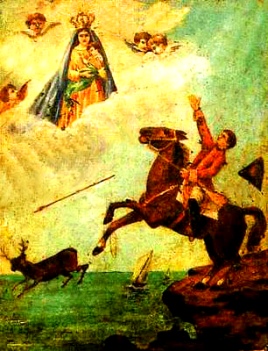
Faus Rouphinho dismounted and went to the grotto to pray and give thanks, subsequently causing a chapel ‘Capela da Memoria,’ or ‘The Chapel of Remembrance,’ to be built very near the spot where his life had been miraculously saved. When the masons he had hired took apart the primitive altar in the cave, they found an ivory box of sorts that contained the relics of Saint Bras and Saint Bartholomew. There was also an ancient scroll that they carefully removed.
Opening the scroll, they found that it explained the history of the statue of the Blessed Virgin Mary and her Divine Child, now known as Our Lady of Nazareth, as outlined above.
The church Santuario de Nossa Senhora da Nazare was later built on the hilltop overlooking Nazare by King Ferdinand I of Portugal in the year 1377. Its construction was necessary due to the large number of pilgrims who continued to come to venerate the image. Over the years it was often rebuilt, or had additions made, especially in the 17th, 18th, and 19th centuries. The profusely decorated and gilded apse displays the statue of Nossa Senhora da Nazare in a lighted niche above the main altar, flanked by twisted columns.
The first King of Portugal, Don Afonso Henriques, as well as the chief nobles of his court, were among the early pilgrims to the shrine. Many notable figures came to visit Our Lady of Nazareth throughout history, including Vasco de Gama, who came as a pilgrim before setting out for India, and Pedro Alvares Cabral, who later discovered Brazil. St Francis Xavier, the Apostle of the East, went on pilgrimage to Our Lady of Nazareth before later leaving for Goa.
According to a plaque placed in the chapel in 1623, the image was carved by Saint Joseph in Galilee when Jesus was a baby. Some decades later St Luke the Evangelist painted the faces and hands of the images. It remained in Nazareth until brought by the Greek monk Ciriaco to the Iberian Peninsula. It is believed to be one of the oldest images venerated by Christians.
Photo courtesy of Georges Jansoone
A story submitted by Joe Aston of Ireland - Thank you, Joe!
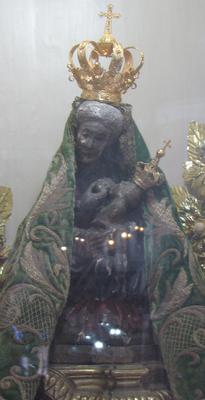
Did Nossa Senhora da Nazaré save me and my crew, Anna and Ger, from drowning in the Bay of Biscay?
One cannot know these things, but it feels to me that she may well have done so!
In 1998, after 26 years as a fisherman on the west coast of Ireland, I turned into a whale-watching sailing skipper, having exchanged my fishing boat for a wooden schooner, the 'Anna M'. By 2011, it was time for both the boat and myself to take our retirement. My wife, Fiona, and I made a sailing pilgrimage to Rome, and then tried to sell the boat in the south of Portugal.
A leaky 50 year-old wooden boat is hard to sell! Fortunately, we found a safe spot on the Río Guadiana, which is the frontier between the Algarve and Andalucía, where we could keep the boat cheaply for the winter. Twice I sailed the boat home to Horseshoe Bay on Sherkin Island for the summer, but the third time last spring was different. I call that run Sailing the ‘Gannetsway’.
Sailing north up the Portuguese coast, things were going well as I followed my desire, sailing happily homewards, but I was worried. The electric bilge pump had too much work to do, although I had made three attempts to cure the leaks by caulking from the outside. I do make a few prayers to Our Lady for guidance on such occasions!
Finally, as we passed the Ilhas Berlingas, I made the decision to put her on the concrete in Nazaré in order to thoroughly investigate the leaks. This involved, as a start, taking the engine out. I had to get help, and found it, from an Englishman named Alec Lammas, who sailed there four years ago and has been working away at boats there ever since. The more we delved, the more damage we found. Although the mahogany planks were in the main very good, the molded oak ribs that held them together had sustained many cracks and fractures. Alec, joined by Stephan from Germany, ripped out the paneling and cabin furniture. More and more fractured ribs were revealed. We all agreed that one more Biscay gale would have almost certainly sent her to the bottom.
Under those circumstances, I had a choice of letting that beautiful 50 year-old boat die, or of setting about restoring her. This we are doing.
I had no idea of the story of the Madonna on the Hill in Nazaré until I went there. Attending Sunday Mass in her Sanctuario has been a great consolation. The liturgy is done beautifully and when the sun shines in on the all the gilt of the sanctuary, the effect is stunning, although one wonders if she would not be more at home in a simpler setting. It would indeed be interesting to see the statue without all the finery. It would also be good to see a model of Vasco da Gama’s ship hanging there, but therein of course lies a problem. All that gold did not come to Portugal in an entirely innocent manner! We can nonetheless assert the human achievement of those sailors who laid the foundations of the modern world, our world itself, for all its faults. With due humility and repentance for our sins, let us re-assert the greatness of our European legacy!
Perched above the extraordinary Atlantic breakers that roll in about the base of the cliffs, ‘Our Lady Protectress of Sailors’ could not have a more appropriate berth! If the sensational story outlined above, about the Madonna’s journey from Nazareth, is true, the world should hear a lot more about it. Personally, I feel sure that she had my safety in hand, just as she had that of Dom Fuas Roupinho; perhaps this is the only kind of proof we need!
Have A Great Story About This Topic?
Do you have a great story? Have You Visited This Shrine? Share it!
What Other Visitors Have Said
Click below to see contributions from other visitors to this page...
'Our Lady, Protectress of Sailors.' Not rated yet
Did Nossa Senhora da Nazaré save me and my crew, Anna and Ger, from drowning in the Bay of Biscay?
One cannot know these things, but it feels to me …
Return to Marian Calendar March
Return to Roman Catholic Saints Home Page from Our Lady of Nazareth
Now Available!!
Pelayo's resistance initiated the nearly 800-year-long Reconquista to take back his country from the ruthless invader who had conquered his homeland and sought to erase his culture and his faith. His actions would lay the foundations of a Kingdom for Christ that would eventually reach around the world and spread the Catholic faith to millions of souls. Read more...
Please help us continue to bring high quality books to our readers at the lowest possible price! Click the link below! Thank you!
Now Available!
Catholic Vitality Publications presents . . .Brand new by
James Fitzhenry
Now in paperback!
Battles - Honor - Miracles! This
book is filled with amazing stories of little-known Catholic heroes presenting
spectacles of bravery and valor never exceeded in all the annals of history. read more. . .
Now Available for $24.95
Also available:
Catholic Vitality Publications
Roman Catholic books currently published by Catholic Vitality Publications:
El Cid, God's Own Champion
-the amazing true story of the life of Rodrigo Diaz, El Cid!
Available for only $22.95
St. Fernando III
A Kingdom for Christ
- King St. Fernando III, born 100
years to the month after the death of
the Cid. His life was filled with miracles
and many conquests!
Available now for $26.95
Discounts available for bulk
orders and for bookstore
retail sales! Just contact us
